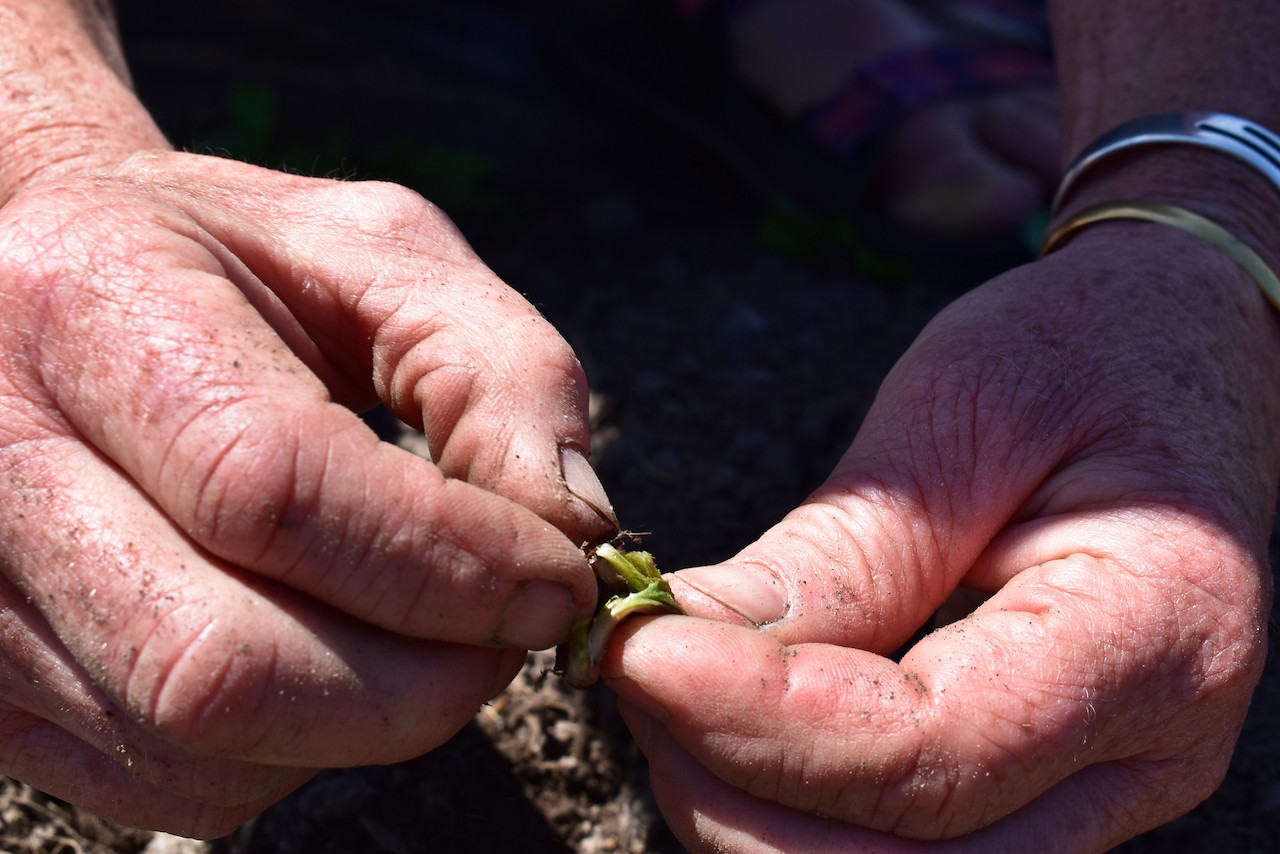Editor’s Note: Whatcom Watch has entered a cooperative agreement with Salish Current. When possible, we will share each other’s content. Salish Current, an online-only news organization, covers the North Sound area and Whatcom Watch mainly covers Whatcom County issues. This article is an exception. Visit https://salish-current.org.
Part 1
by Kai Uyehara

Christine Langley pulls apart the stem of a wilted lettuce plant, looking for a wireworm. Pale in color and around an inch long, wireworms hollow out the stems of lettuce and damage crops underground.
photo: Kai Uyehara /Salish Current ©2023
Christine Langley, owner of Lopez Harvest farm (1) on Lopez Island, combed over her rows of lettuce looking for wilted leaves. Finding a stunted and drooping head of lettuce, she dug into the topsoil and unearthed the stem, which she peeled apart to expose the culprit: a wireworm.
Wireworm damage first appeared on Langley’s 10-acre organic farm about 15 years ago, and she had no idea what they were. Now, wireworms are her biggest pests.
“It definitely was an obstacle for me when I was expanding my operation, because I relied pretty heavily on lettuces and other greens like that,” Langley said. At the beginning, “I used to plant about 600 lettuces every week for about 16 weeks and I started finding that I would have 40 percent of my lettuces go down. You can’t really absorb that amount of loss. I mean, I cried.”
Her experience is increasingly common among produce growers in Northwest Washington, especially those who are beginning or expanding their plantings. Wireworms are an issue on many farms, but growers who are farming organically on converted pastureland tend to face what amounts to an entry fee in the form of a hard-to-manage pest. In addition to challenges of seed selection, cultivation, harvesting, budgeting and marketing, they have to learn to cope with a prolific and tenacious predator.
Larval Form of Some Click Beetles
Wireworms (2) bore into the below-ground portions of potatoes, lettuce, tomatoes, corn and other crops, killing or stunting the plant. They are the larval form of several species of click beetles and can be as small as one-fourth of an inch to as large as an inch-and-a-quarter long.
Adult click beetles each lay hundreds of eggs. Wireworms eat a wide range of crops, live in the soil year-round in a multitude of age groups and can move up and down in the soil, retreating further below crops if it’s too hot, cold or dry on the surface.
Their adaptability makes them very hard to get rid of completely, said Brook Brouwer, former farmer, and, since 2016, director of San Juan County’s Washington State University Extension office. Brouwer has conducted studies in the San Juan Islands, sampling wireworm populations and experimenting with mitigation techniques.
The larvae mature underground for three to 10 years before they pupate and emerge in late summer, meaning there are generations feeding below ground at any given time, Brouwer said.
Two species of wireworm, Agriotes lineatus and Agriotes obscurus, are primary pests for Washington farmers and cause serious economic damage to high value crops, WSU researchers have found. (3)
These species arrived in British Columbia around 1900 from European countries, Agriculture Canada Vancouver researchers reported. (4) The pests slowly migrated south and were discovered in San Juan, Skagit and Whatcom counties in 1997, per WSU studies. (5)
“I have talked to farmers who have basically lost entire crops to wireworm damage,” Brouwer said.
Wireworms reduce farmers’ yields not only by killing crops as they hollow out stems, but also by reducing the marketability of crops that can withstand damage by creating unappetizing looking holes.
Into New Ground
The beginning of an organic farmer’s relationship with wireworms usually starts when they break ground to establish their farm.
Christine Langley pulls apart the stem of a wilted lettuce plant, looking for a wireworm. Pale in color and around an inch long, wireworms hollow out the stems of lettuce and damage crops underground.
Wireworms are endemic in pastures, feeding primarily on grasses and not causing any particular harm until farmers give them something new to eat.
“You come in and till up that ground and plant a garden and there’s just a big pile of wireworms there looking for food,” Brouwer said, “that’s where I see the worst damage and loss happening.”
Because San Juan County is rich in pastures and hayfields, many farmers endure an initiation into their new plots. These infestations affect established organic farms and larger conventional agriculture farms, too, but wireworms can become less harmful over time as cultivation over the life of those farms regularly disturbs their habitat.
In an ironic twist, the practices of building up healthy soil and reducing tillage — two practices of regenerative agriculture — create ideal conditions for the worms to flourish.
A Wake-Up Call … From Worms
Mara Lawrence, who owns the six-acre Mama Bird Farm (6) on San Juan Island, also saw initial wireworm damage in her cucumber and tomato plants, but currently has then under control. Langley’s wireworm losses at Lopez Harvest are also manageable at this point, ranging from minimal to 20 percent.
Viva Farms (7) in Skagit and King counties was caught by surprise in 2018 after they expanded to a second location, said programs and operations director Rob Smith. The Skagit County farm center, which hosts aspiring businesses in incubator farms, purchased a 45-acre property that had been used for hay cultivation. [See “Who will farm to feed the people?,” Salish Current, Oct. 28, 2022 (8).]
“There were some farmers within our program that experienced some pretty significant wireworm pressure on some of their key crops, specifically lettuce and some strawberries,” Smith said. “That was a wake-up call for those farmers and for Viva Farms as an organization.”
Smith saw a farmer lose about 35 percent of his lettuce when the second location started up. Now, Viva is combatting the pests with knowledge and preparation and the toll has lessened.
A Moving Target
Wireworms are hard to eliminate, so managing damage is a moving target for many farmers.
No organically sourced insecticides have been found effective against wireworms, per WSU Extension research. Conventional agricultural farmers have more options, but they also suffer wireworm infestations, Brouwer said. In fact, phasing out carbamate, organophosphate and organochlorine insecticides for health and environmental reasons may have given wireworms room to thrive, WSU Extension researchers reported. (9)
Because of their relatively recent appearance in Northwest Washington, there isn’t much generational knowledge to share within the agricultural industry. Viva reached out to the WSU Northwest Research Center, which has been conducting wireworm surveys and management trials.
The farm center began teaching more about wireworms in their practicums for new growers, hosting wireworm workshops, sharing local research, having farmers inspect wireworms under microscopes and detailing ways to control infestations with organic methods.
Once a farmer identifies a wireworm infestation, “there’s not really one easy way to get rid of them, and trying to integrate as many different management strategies as you can to help manage them is all part of a puzzle,” Brouwer said.
Frequent tilling, particularly in early and late summer, can disrupt wireworms by creating a hostile habitat, Brouwer said. But this is time-consuming and can be detrimental to soil health. It’s a difficult tradeoff to make.
Mustard has been the only reliably successful wireworm deterrent that Christine Langley has found. When tilled before it blooms, mustard releases a toxin that kills wireworms.
“We’re really trying to figure out how to work the soil less as we organic farmers try to build organic matter,” Langley said. But “wireworms, they’re attracted to CO2, they’re attracted to decomposing organic matter. So all the things that you really don’t want to do, like till the soil or minimize the organic matter, those aren’t things that we want to do for all the other reasons.”
Fighting Back
Farmers also adapt their production away from more vulnerable plants like lettuce, opting for crops that can tolerate more damage. Some brassicas such as mustards and cabbages, produce a compound that acts as a repellent, Brouwer said, mentioning that he’s heard that buckwheat may be toxic to wireworms as well.
Not many management techniques have worked for Langley, but planting mustard near her lettuce and mowing it before it blooms seems to kill her wireworms. She also plants carrots, onions, squash and peas on areas of her farm where wireworms would destroy her lettuce because they don’t seem to bother these alternate crops.
Lawrence now grows her tomato plants larger before transplanting them, making them stronger against the feeding wireworms. She also employed trap cropping, a technique that baits wireworms away from prized produce with a dispensable crop. Lawrence buried potatoes, which were more attractive to the worms than tomatoes. She impaled them on a stick for easy removal. Then she pulled the bait from the ground and killed the pests with a knife.
In his research, Brouwer and his comrades studied trap cropping by planting wheat among lettuce and found the tactic effective, though it demands extra space and time in a farmer’s production system.
Langley tried that but found the tactic impractical. “I was planting a 100-foot row (about) every week and I just couldn’t see doing that on that scale,” Langley said. “Time is money if you’re having to hire people to do it with you.”
Because managing wireworms is so challenging and they can’t be eliminated, Smith advises diligent preparation before cultivating.
“It’s a lot of knowing how to precisely rotate your crops in a way that’s not setting yourself up for the wireworm,” Smith said. Larvae are deeper in the ground during hotter, colder or drier months, so Smith advises new farmers to plant susceptible crops when pressure from wireworms will be lowest and plant more resilient crops when the worms are active.
Langley grows lettuce earlier in the season to skirt high wireworm activity in the late season and avoids a section of her farm where the population is high. She’d planted sweet corn in the same area and saw it destroyed.
“If your farm is set up to grow a lot of wheat and then rotate with potatoes, but you need to switch to a different crop in your rotation, that can be a huge change,” Brouwer said. “It may not be something that there’s easy markets for.”
Taking the Long View
After Viva Farm alumni move on to their own new farms and face down wireworm infestations on their cultivated ground, Viva maintains relationships and offers resources. They encourage farmers to trap crop new land, to assess wireworm pressure in the area, to inquire about the plot’s tillage history and to engage with local Extension offices.
“You’re never going to eliminate the population,” Langley said. “You just want to sort of suppress it for a little while.”
Langley converses with neighboring farmers yearly about wireworms and finds surprising differences in the crops their infestations do or don’t affect, and the techniques that work for one farm but not another.
“I feel like there are way more questions than there are answers,” she said.
Endnotes
- https://eatlocalfirst.org/listing/lopez-harvest/
- https://extension.usu.edu/pests/research/wireworms
- https://s3.wp.wsu.edu/uploads/sites/2056/2019/07/Brouwer-2019-OFRF-wireworm-poster-reduced-1.pdf
- https://journal.entsocbc.ca/index.php/journal/article/view/1873
- https://projects.sare.org/wp-content/uploads/FS364E.pdf
- https://mamabirdfarm.com/about
- https://vivafarms.org/
- https://salish-current.org/2022/10/28/who-will-farm-to-feed-the-people/
- https://pubs.extension.wsu.edu/biology-and-management-of-wireworms-in-western-washington
_______________________
Kai Uyehara (he/him/his) is freelance reporter for Salish Current and a recent graduate from Western Washington University. He graduated with a major in English creative writing and a minor in news/editorial journalism. He is originally from Glenwood Springs, a small town in Colorado. Kai is interested in reporting on stories concerning and intersecting with social issues




























